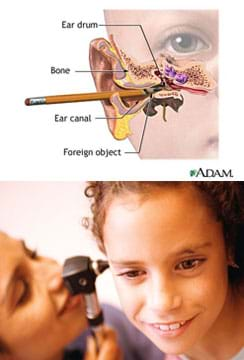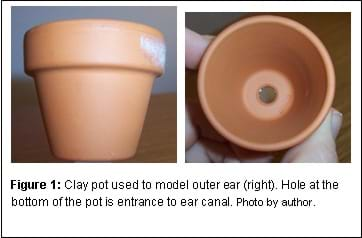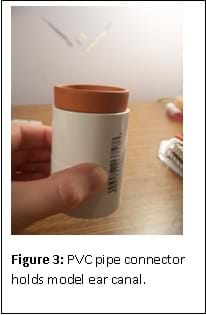
Summary
Students learn the engineering design process by following the steps, from problem identification to designing a device and evaluating its efficacy and areas for improvement. A quick story at the beginning of the activity sets up the challenge: A small child put a pebble in his ear and we don't know how to get it out! Acting as biomedical engineers, students are asked to design a device to remove it. Each student pair is provided with a model ear canal and a variety of classroom materials. A worksheet guides the design process as students create devices and attempt to extract pebbles from the ear canal.Engineering Connection
The activity challenge is one that real-world biomedical engineers actually face. Students follow the steps of the engineering design process to design, build and test prototype medical devices. They are asked to think of what other materials could be applicable in this situation and what other principles engineers might need to consider to solve this problem. Similarly, engineers do research and review prior art before attempting to solve problems. Students also learn about engineering a bit beyond the obvious. For example, they may not have all the materials they want or a classmate may have used the last bit of glue, so they are faced with limitations. Engineers rarely have all the resources they want to solve problems. Limits on technological capabilities, funds and time require creativity and teamwork to overcome.
Learning Objectives
After this activity, students should be able to:
- List the steps of the engineering design process.
- Describe the work of biomedical engineers and give examples.
- Draw at least one connection from a science class lesson to the work of engineers.
Educational Standards
Each TeachEngineering lesson or activity is correlated to one or more K-12 science,
technology, engineering or math (STEM) educational standards.
All 100,000+ K-12 STEM standards covered in TeachEngineering are collected, maintained and packaged by the Achievement Standards Network (ASN),
a project of D2L (www.achievementstandards.org).
In the ASN, standards are hierarchically structured: first by source; e.g., by state; within source by type; e.g., science or mathematics;
within type by subtype, then by grade, etc.
Each TeachEngineering lesson or activity is correlated to one or more K-12 science, technology, engineering or math (STEM) educational standards.
All 100,000+ K-12 STEM standards covered in TeachEngineering are collected, maintained and packaged by the Achievement Standards Network (ASN), a project of D2L (www.achievementstandards.org).
In the ASN, standards are hierarchically structured: first by source; e.g., by state; within source by type; e.g., science or mathematics; within type by subtype, then by grade, etc.
NGSS: Next Generation Science Standards - Science
| NGSS Performance Expectation | ||
|---|---|---|
|
MS-ETS1-1. Define the criteria and constraints of a design problem with sufficient precision to ensure a successful solution, taking into account relevant scientific principles and potential impacts on people and the natural environment that may limit possible solutions. (Grades 6 - 8) Do you agree with this alignment? |
||
| Click to view other curriculum aligned to this Performance Expectation | ||
| This activity focuses on the following Three Dimensional Learning aspects of NGSS: | ||
| Science & Engineering Practices | Disciplinary Core Ideas | Crosscutting Concepts |
| Define a design problem that can be solved through the development of an object, tool, process or system and includes multiple criteria and constraints, including scientific knowledge that may limit possible solutions. Alignment agreement: | The more precisely a design task's criteria and constraints can be defined, the more likely it is that the designed solution will be successful. Specification of constraints includes consideration of scientific principles and other relevant knowledge that is likely to limit possible solutions. Alignment agreement: | All human activity draws on natural resources and has both short and long-term consequences, positive as well as negative, for the health of people and the natural environment. Alignment agreement: The uses of technologies and any limitations on their use are driven by individual or societal needs, desires, and values; by the findings of scientific research; and by differences in such factors as climate, natural resources, and economic conditions.Alignment agreement: |
| NGSS Performance Expectation | ||
|---|---|---|
|
MS-ETS1-2. Evaluate competing design solutions using a systematic process to determine how well they meet the criteria and constraints of the problem. (Grades 6 - 8) Do you agree with this alignment? |
||
| Click to view other curriculum aligned to this Performance Expectation | ||
| This activity focuses on the following Three Dimensional Learning aspects of NGSS: | ||
| Science & Engineering Practices | Disciplinary Core Ideas | Crosscutting Concepts |
| Evaluate competing design solutions based on jointly developed and agreed-upon design criteria. Alignment agreement: | There are systematic processes for evaluating solutions with respect to how well they meet the criteria and constraints of a problem. Alignment agreement: | |
| NGSS Performance Expectation | ||
|---|---|---|
|
MS-ETS1-4. Develop a model to generate data for iterative testing and modification of a proposed object, tool, or process such that an optimal design can be achieved. (Grades 6 - 8) Do you agree with this alignment? |
||
| Click to view other curriculum aligned to this Performance Expectation | ||
| This activity focuses on the following Three Dimensional Learning aspects of NGSS: | ||
| Science & Engineering Practices | Disciplinary Core Ideas | Crosscutting Concepts |
| Develop a model to generate data to test ideas about designed systems, including those representing inputs and outputs. Alignment agreement: | Models of all kinds are important for testing solutions. Alignment agreement: The iterative process of testing the most promising solutions and modifying what is proposed on the basis of the test results leads to greater refinement and ultimately to an optimal solution.Alignment agreement: | |
International Technology and Engineering Educators Association - Technology
-
Students will develop an understanding of the attributes of design.
(Grades
K -
12)
More Details
Do you agree with this alignment?
-
Students will develop an understanding of engineering design.
(Grades
K -
12)
More Details
Do you agree with this alignment?
-
Students will develop abilities to apply the design process.
(Grades
K -
12)
More Details
Do you agree with this alignment?
-
Advances and innovations in medical technologies are used to improve healthcare.
(Grades
6 -
8)
More Details
Do you agree with this alignment?
State Standards
Virginia - Science
-
The student will demonstrate an understanding of scientific reasoning, logic, and the nature of science by planning and conducting investigations in which
(Grades
7 -
8)
More Details
Do you agree with this alignment?
-
models and simulations are constructed and used to illustrate and explain phenomena;
(Grades
7 -
8)
More Details
Do you agree with this alignment?
Materials List
Each group needs:
- model ear canal (see attachment on how to assemble)
- 1½'' clay pot (available at crafts stores)
- 1½'' PVC pipe connector (available at hardware stores)
- plastic tubing ½'' outer diameter, 3/8'' inner diameter (available at hardware stores)
- o-ring to fit over ½" plastic tubing (such as Danco #8, available at hardware stores)
- vegetable bag from grocery store (only 2 or 3 are needed per class)
For the entire class to share. (You may not need all items; most are available from crafts or drug stores)
- small pebbles (required)
- popcorn kernels (required)
- clay
- glue dots
- scissors
- pipe cleaners
- rubber bands
- glue (rubber cement, hot glue, Elmer's glue)
- dowel rods (big and little)/small sticks
- miniature clothes pins
- paper clips
- wire
- small fuzzy pom poms, or other small fuzzy object
- tape
- tweezers
- magnets
- oral syringes (available at drug stores)
- any other classroom items or small item that could be included in the invention
Worksheets and Attachments
Visit [www.teachengineering.org/activities/view/uva_eardevice_act] to print or download.Pre-Req Knowledge
Familiarity with human ear anatomy and function. A good resource to learn this is HowStuffWorks.com's page titled, "Why do loud noises cause your ears to Ring?"
Introduction/Motivation
(Picking up from where we left off in the associated lesson...) So now it is your turn to be biomedical engineers! We have a new problem. Let's pretend you have a little brother named Scotty. You and Scott are playing in the backyard in the summer and you run inside to get a drink of water. While you are gone, Scott remembers his crazy uncle telling him that if he put a rock in one of his ears, it would come out the other. You are all smart and know from studying the anatomy of the ear that this is NOT the case. Scott is really young, though, and doesn't know any better so he tries it. And guess what? It doesn't come out the other side. What worse is that he pushed it so far down in there that it isn't coming back out when he tilts his head to the side! He goes inside crying to your mom, your mom takes him to the doctor, and the doctor doesn't have any tools to get it out. SO you're the biomedical engineer!
Your engineering challenge is to design a device to extract the pebble from Scotty's ear. You should have a worksheet in front of you. Work through number 6, then go get materials to design the device you select. I will pass out the model ear canals and the rocks so you have them for reference.
Procedure
Background
Small children are curious creatures. As a method of exploration, they often stick small objects in their noses and ears including beads, popcorn kernels, small sponges, toys and rocks. Currently, doctors have limited tools to extract these objects. Various tools—tweezers and hooks—and flushing methods are used, but spherical objects are difficult to grasp with tweezers and sponges just absorb water used for flushing! Biomedical engineers at the University of Virginia are currently developing a device that extracts all types of foreign bodies from ear canals. This activity asks students to design their own devices to solve this problem.
Before the Activity
- Make copies of the worksheets and quizzes.
- Assemble model ear canals; refer to the Teacher's Guide - Assemble Ear Model for instructions.
- Make overhead slides of ear diagram and pictures of ear tubes and ear tube insertion device.
- Put all class material out on a table.
- Put a small rock in each model ear.
Prepare the class materials:
Shared materials—Collect these from available school supplies: clay, glue, pipe cleaners, scissors, Popsicle sticks, small dowel rods, glue dots. Obtain remaining items at crafts stores.
Team materials—for the model ear canal:
- vegetable bags
- 1½'' clay pots (see Figure 1), available at crafts stores for 50-60¢ each.
- 3 items from hardware stores::
- rigid plastic tubing (see Figure 2), get plastic tubing with an outer diameter of ½'' and inner diameter of 3/8'', which is printed on the tubing and on signs above large rolls of tubes; ~20¢ per foot; usually located the PVC pipe section of the store; get ~3 feet
- o-rings (see Figure 2), such as Danco O-Rings, $1.20 for package of 10; get two packages of #8; usually located near the PVC and tubing section of the store
- PVC connector pipe (see Figure 3), used to simply hold the clay pot, size: ~ 2.5 inches tall and ~2 inch diameter; take a clay pot to the store and just make sure it rests properly


With the Students
- As students walk into the room for clas, pass out the quizzes. Do this in the few minutes before the bell rings for class and as everyone settles in.
- After the lesson is complete, divide class into student pairs.
- Make sure students have the worksheets (should have been handed out during the lesson).
- Direct students to work through step 6 on the worksheet before choosing supplies to make their devices.
- As groups are working on the worksheets, pass out the model ear canals.
- While students are completing the worksheets and designing, circulate and answer questions and encourage creativity with the designs. Also, check the supply table regularly, reminding students to take only what is necessary and return to their seats to build.
- After students successfully extract a pebble once, ask them to do it a second time. Repeatability is important in developing a reliable medical device.
- After a successful second extraction, have students use their same device to extract a small fuzzy pom-pom and a popcorn kernel.
- If they finish this, ask "Did you have any problems with your device?" or "How could you make your device better if you were to use it with a real person?" If students do not have materials available to make the changes they would like, ask them to list the materials and describe how they would make the changes on the worksheet.
- If a group punctures the ear canal, simply cut another from the veggie bags and replace!
- Towards the end of the design period, hand out the quizzes to be completed as homework.
- At the end of the design period, have groups describe their devices, explain a challenge or problem they had, and how it might be resolved with more time or different resources.
Vocabulary/Definitions
constraint: A design equirement. It might be a quality, feature or specification the final design must have, contain or meet.
Assessment
Pre/Post Quizzes: As students enter the classroom, before starting the activity, administer the Pre-Assessment Quiz . At activity end, administer the same quiz. Compare student answers to gauge their changes in content knowledge.
Writing: Ask students to write answers to the following questions:
- What are two examples of products designed by biomedical engineers?
- How do engineers go about problem solving? What are the steps of the engineering design process.
- What are two examples of how subjects learned in science or math class can be applied to engineering problem solving?
Safety Issues
- Emphasize that the devices designed are strictly for use in the model ear canal, not in the ear canals of real people. These are prototype designs that have not been tested for safety.
- Students should not put small rocks and other objects in their ears to see if they can get them out by tilting their heads to the side, or for any other reasons. Remind them to be smart about the activity!
- Remind students that only trained healthcare professionals should stick things into their ears!
- The following articles describe treatments for dealing with foreign objects in the ear. Q-tips should not be used to clean objects from inside the ear.
- Ear Foreign Body Treatment from WebMD
- EarWax from WebMD
- All Ears: Q-Tips – Weapons of Ear Destruction? From WebMD
Troubleshooting Tips
If students have trouble starting the activity, work through the first few steps as a class.
Activity Extensions
Think of other devices that biomedical engineers could design.
Think of other medical problems from your own experiences or the experiences of family and friends and discuss what engineers could design as solutions for those problems.
Subscribe
Get the inside scoop on all things TeachEngineering such as new site features, curriculum updates, video releases, and more by signing up for our newsletter!More Curriculum Like This

Students are introduced to engineering, specifically to biomedical engineering and the engineering design process, through a short lecture and an associated hands-on activity in which they design their own medical devices for retrieving foreign bodies from the ear canal. Through the lesson, they lea...

Students follow the steps of the engineering design process to create their own ear trumpet devices (used before modern-day hearing aids), including testing them with a set of reproducible sounds.

Students learn about the function and components of the human nervous system, which helps them understand the purpose of our brains, spinal cords, nerves and five senses. In addition, how the nervous system is affected during spaceflight is also discussed.
References
Ear Infections. Last Updated: March 16, 2010. MedlinePlus. Accessed March 28, 2010. http://www.nlm.nih.gov/medlineplus/earinfections.html
Engineering design process. Last Modified: March 26, 2010. Wikipedia. Accessed March 28, 2010. http://en.wikipedia.org/wiki/Engineering_design_process
Richardson, Karen. Miracles in the Making. Created Fall 2005. Wake Forest University Baptist Medical Center. Accessed March 28, 2010. http://www2.wfubmc.edu/MedicalCenter/news_templates/featured_article.aspx?NRMODE=Published&NRORIGINALURL=%2Farticles%2FMiracles%2Bin%2Bthe%2BMaking%2F&NRNODEGUID={696AB72B-0A8C-4983-8498-45E0246181C2}&NRCACHEHINT=Guest
Conger, Cristen. Why do loud noises cause your ears to ring? HowStuffWorks, Discovery Company. Accessed March 28, 2010. http://health.howstuffworks.com/loud-noise-ear1.htm
Copyright
© 2013 by Regents of the University of Colorado; original © 2007 University of VirginiaContributors
Shayn Peirce-Cottler; Leyf Starling; Derek Harbin; Krista WarnerSupporting Program
Biomedical Engineering, University of VirginiaAcknowledgements
Created by students in Dr. Shayn Peirce-Cottler's biomedical engineering senior design course.
Last modified: October 20, 2020










User Comments & Tips